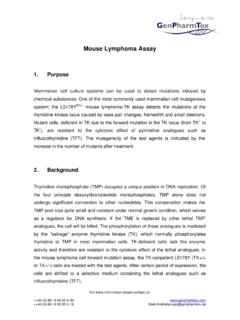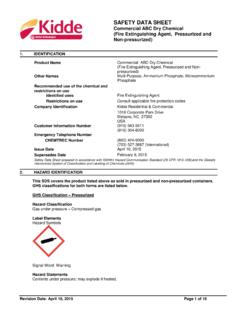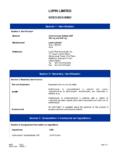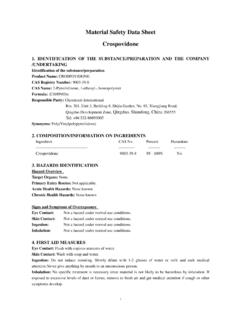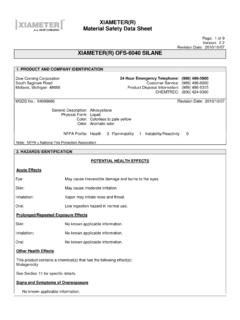Transcription of NEW ZEALAND DATA SHEET 1. PRODUCT NAME
1 Internal document code cip200818iNZ 1 NEW ZEALAND DATA SHEET 1. PRODUCT NAME CIPROXIN HC Ear Drops ciprofloxacin and hydrocortisone 1%. 2. qualitative AND quantitative COMPOSITION Ciproxin HC Ear Drops contain mg ciprofloxacin hydrochloride (equivalent to ciprofloxacin % w/v) and hydrocortisone 100 mg (1% w/v). Excipient with known effect Benzyl alcohol 9 mg in 1 mL as a preservative. For the full list of excipients, see section 3. PHARMACEUTICAL FORM Ear drops. 4. CLINICAL PARTICULARS Therapeutic indications The treatment of acute bacterial external otitis caused by organisms susceptible to the action of ciprofloxacin, including Pseudomonas aeruginosa, Staphylococcus aureus, Acinetobacter anitratus (baumannii), Stenotrophomonas maltophilia, Enterobacteriaceae, Enterococcus faecalis and Proteus mirabilis. Dose and method of administration For children (aged two years and older) and adults, three drops of the suspension should be instilled into the affected ear twice daily for seven days.
2 The bottle should be shaken well, immediately before use. The patient should tilt the head to one side with the affected ear upward and then the drops should be instilled. This position should be maintained for a minimum of 30 seconds to facilitate penetration of the drops into the external ear canal. Repeat, if necessary, for the opposite ear. Patient instructions for use/handling Remove the closure and put the dropper assembly in place on the bottle. Ciproxin HC Ear Drops is a ready to use when dropper assembly is placed on the bottle. Shake well immediately before using. Warm to room temperature prior to application. Avoid contaminating the dropper with material from the ear, fingers or other sources. Discard unused portion after therapy is completed. Keep all medicines out of the reach of children. Internal document code cip200818iNZ 2 Contraindications Ciproxin HC Ear Drops are contraindicated in patients being treated for necrotizing malignant otitis externa.
3 This condition, which is particularly common in diabetes, should be treated with systemic anti-pseudomonal agents. Ciproxin HC Ear Drops should not be used to treat viral or fungal infections of the external ear canal unless it is suspected that there is a secondary bacterial infection present which will respond to topical ciprofloxacin. Ciproxin HC Ear Drops is not indicated for the treatment of otitis media. Known hypersensitivity to benzyl alcohol, hydrocortisone, ciprofloxacin or other quinolone antimicrobial agents, or any of the excipients listed under ) below. Special warnings and precautions for use The safety and efficacy of Ciproxin HC Ear Drops have not been studied in the presence of a perforated tympanic membrane. Ciproxin HC Ear Drops are, therefore, not recommended in patients with known or suspected perforation, or where there is a risk of perforation of the tympanic membrane.
4 Serious and occasionally fatal hypersensitivity (anaphylactic) reactions, some following the first dose, have been reported in patients receiving systemic quinolones. Ciproxin HC Ear Drops should be discontinued at the first appearance of any sign of local or general hypersensitivity. Ciproxin HC Ear Drops are not for ophthalmic use. As with other antibiotic preparations, prolonged use may result in overgrowth of nonsusceptible organisms, including fungi. If superinfection occurs, appropriate therapy should be initiated. If an infection is not improved after one week, cultures and susceptibility tests should be performed to verify the identity of the organism and to determine what alternative therapy should be initiated. Moderate to severe phototoxicity has been observed in some patients exposed to direct sunlight while receiving some members of the quinolone class of medicines, including ciprofloxacin.
5 The dropper cap contains natural rubber (latex) which may cause severe allergic reactions. Visual Disturbance Visual disturbance may be reported with systemic and topical corticosteroid use. If a patient presents with symptoms such as blurred vision or other visual disturbances, the patient should be considered for referral to an ophthalmologist for evaluation of possible causes which may include cataract, glaucoma or rare diseases such as central serous chorioretinopathy (CSCR) which have been reported after use of systemic and topical corticosteroids. Interactions with other medicinal products and other forms of interactions Internal document code cip200818iNZ 3 Ciproxin HC Ear Drops should be administered separately, because the compatibility of other medicines with this formulation is unknown. Specific systemic medicine interactions are not expected to occur with Ciproxin HC Ear Drops, because they are minimally absorbed.
6 Fertility, pregnancy and lactation Pregnancy Category B3 No adequate and well controlled studies have been performed in pregnant women. Caution should be exercised when Ciproxin HC Ear Drops are used by a pregnant woman. Refer to Section Pre-clinical safety data pregnancy for pre-clinical reproductive studies. Breast-feeding Ciprofloxacin/metabolites are excreted in human milk with systemic use. It is not known whether ciprofloxacin or hydrocortisone/metabolites are excreted in human milk following otic topical administration. Because of the potential for serious adverse reactions in nursing infants, a decision should be made whether to discontinue nursing or to discontinue the medicine, taking into account the importance of the medicine to the mother. Caution should be exercised with the use of Ciproxin HC Ear Drops since there is no experience of the medicine s safety in nursing mothers.
7 Effect on fertility Preclinical data in fertility is included in section Preclinical safety data, fertility. Effects on ability to drive or use machines There are no known effects of Ciproxin HC Ear Drops on the ability to drive and use machines. Undesirable effects Clinical Trials There are no placebo controlled studies of the efficacy and safety of Ciproxin HC Ear Drops. In clinical trials against the active control (polymixin B [10,000 IU], neomycin [ ] and hydrocortisone [10mg/mL]), the following adverse events were recorded in more than 1% of patients. All adverse events* occuring in more than 1% of patients (%) Adverse Events Ciproxin HC Ear Drops (n=564) Active Control (n=554) Any adverse event 18 15 Body as a whole 9 5 Internal document code cip200818iNZ 4 All adverse events* occuring in more than 1% of patients (%) Adverse Events Ciproxin HC Ear Drops (n=564) Active Control (n=554) Headache 5 3 Infection 1 Fever 6 Digestive System 2 3 Nausea Nervous system Respiratory System 3 2 Skin and appendages 2 2 Pruritus Special senses 4 4 Otitis externa** Otitis media 1 * Includes any adverse events, whether considered to be medicine-related or not.
8 ** Indicates otitis externa of the non-treated ear, During clinical trials, adverse events considered to be at least possibly related to treatment occurred in of patients using Ciproxin HC Eye Drops. Medicine related events reported with an incidence of between and 1% were hypoaesthesia, paraesthesia, pruritus, rash, urticaria, ear pain, ear disorder and a sensation of fullness of the ear. Headache ( ) has also been reported. Post Marketing Experience The following adverse reactions have been reported during clinical studies with Ciproxin HC Ear Drops and are classified according to the subsequent convention: very common ( 1/10), common ( 1/100 to <1/10), uncommon ( 1/1,000 to <1/100), rare ( 1/10,000 to <1/1,000) and very rare (<1/10,000). Within each frequency-grouping, adverse reactions are presented in order of decreasing seriousness.
9 Internal document code cip200818iNZ 5 Ear and labyrinth disorders Common ( 1% to < 10%): ear pruritus. Uncommon ( to < 1%): ear pain, ear congestion, ear discomfort, ear canal erythema. Infections and infestations Uncommon ( to < 1%): fungal skin infection. Nervous system disorders Uncommon ( to < 1%): dizziness, headache. Gastrointestinal disorders: Uncommon ( to < 1%): nausea. Skin and subcutaneous tissue disorders Uncommon ( to < 1%): skin exfoliation, urticaria, rash, pruritus. General disorders and administration site conditions: Uncommon ( to < 1%): medication residue. Additional adverse reactions identified from post-marketing surveillance include the following. Frequencies cannot be estimated from the available data. Ear and labyrinth disorders Not known: hypoacusis, tinnitus. Very rare cases of PRODUCT residue in the ear canal with or without symptoms such as ear discomfort, hearing disorders, ear pain have been reported during post-marketing experience.
10 Eye Disorders Vision Blurred (see Section Special Warnings and Precautions for Use). Reporting of suspected adverse reactions Reporting suspected adverse reactions after authorisation of the medicine is important. It allows continued monitoring of the benefit/risk balance of the medicine. Healthcare professionals are asked to report any suspected adverse reactions Overdose There have been no reports of overdosage with Ciproxin HC Ear Drops in humans. However, in pre-clinical studies guinea pigs treated with at least twenty times the equivalent human dosage showed no toxic effects. No significant toxic effects are to be expected in an acute otic overdose, nor in the event of accidental ingestion of Ciproxin HC Ear Drops. For advice on the management of overdose please contact the National Poisons Centre on 0800 POISON or 0800 764 766.










